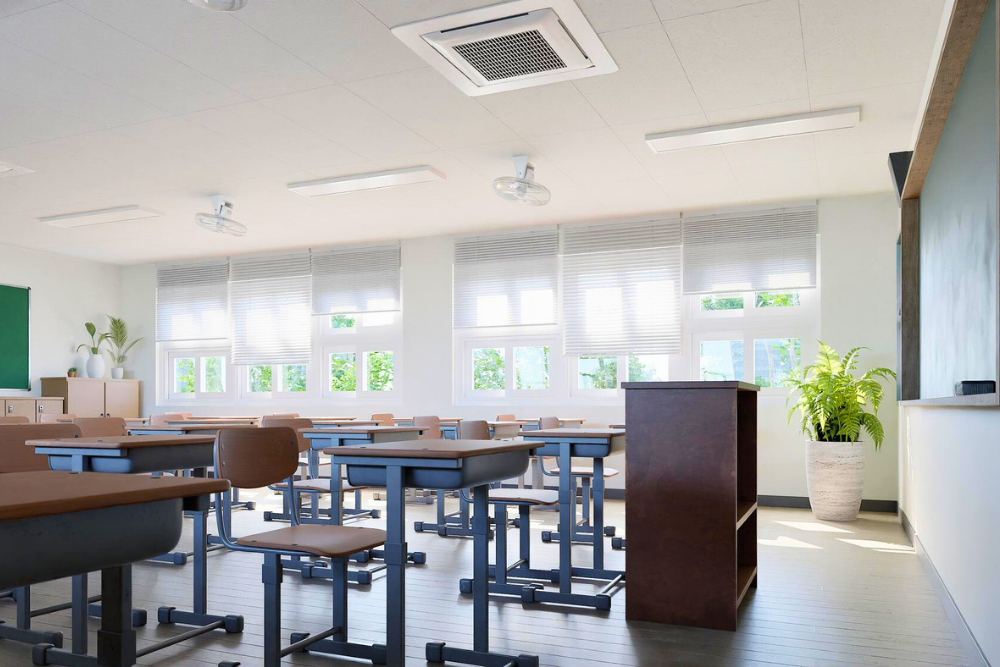When we think of student success, we picture homework, teachers, and textbooks. But what about the air they breathe in the classroom?
Studies have shown a clear link between school air quality and student performance. Poor ventilation, indoor pollutants, and mold can all lead to fatigue, poor concentration, asthma attacks, and more absences. These effects directly impact learning, behavior, and even test scores.
If you’re a parent, this is a silent threat you can no longer ignore.
1. What the Science Says: Air Quality and Academic Performance
A Harvard study found that students exposed to poor indoor air quality scored lower on cognitive tests. Another EPA-backed study showed that schools with improved ventilation and lower carbon dioxide levels saw higher performance in math and reading.
Bad air = bad grades.
It’s that simple.
Pollutants like carbon monoxide, volatile organic compounds (VOCs), and fine particles (PM2.5) can build up quickly in sealed buildings—especially in older schools with aging HVAC systems.
2. Health Risks Linked to Poor Air in Schools
If your child suffers from frequent colds, headaches, allergies, or asthma during the school year, their school’s air may be the hidden cause.
Common issues include:
- Mold growing in vents or walls
- Dust and pollen buildup
- High humidity and poor airflow
- Contaminants from cleaning products or construction
Children are more vulnerable than adults to airborne toxins. Their lungs are still developing, and they spend 6+ hours daily indoors at school.
🔄 Also Read: Is Your Child’s School Really Safe?
If you care about school safety, you’ll also want to understand the hidden risks in school facilities. Don’t miss this eye-opening read!
3. Symptoms That May Be Caused by Indoor Air Quality
Ask yourself:
- Is my child constantly tired after school?
- Do they complain of headaches or itchy eyes in the classroom?
- Are their allergies worse during the school week?
These are all red flags that the school’s air may be affecting your child’s health—and ability to concentrate.
📌 Many parents mistake these issues for general fatigue or illness, but in reality, airborne irritants may be silently undermining learning.
4. How Air Quality Impacts Focus and Behavior
Bad air doesn’t just harm the body—it slows the brain.
Symptoms of poor air in classrooms include:
- Reduced attention span
- Difficulty following instructions
- Increased behavioral incidents
- More frequent trips to the nurse’s office
Why? Because low oxygen, high CO₂, and airborne chemicals all affect the brain’s ability to retain information and stay alert.
🧠 Clean air literally boosts cognitive function, especially in young children.
5. What Can Parents Do?
You don’t need to be a scientist or facility manager to demand better air.
Here are 4 steps you can take right now:
- Ask about HVAC maintenance and filter replacements
- Request an air quality report from the school district
- Visit the school and check for mold, odors, or stuffiness
- Speak to other parents and raise the issue at PTA meetings
Your voice can lead to change—especially when backed by science and concern for student wellbeing.
6. Cleaning and Maintenance Matter
A school may look clean, but without technical cleaning services—such as vent cleaning, mold prevention, and humidity control—the problems remain hidden.
Our company specializes in school facility services that help ensure classrooms meet air quality standards and protect your child’s health.
Want to learn how we can help?
📧 Contact us at: connect@jessicanevespereira.com
Amazon Product Recommendations for Concerned Parents
Looking to protect your child’s health beyond the classroom? Here are three must-haves:
- LEVOIT Air Purifier for Home & Bedrooms
Captures 99.97% of airborne particles, allergens, and dust—ideal for children with asthma or allergies.
👉 Buy on Amazon - Dr. Talbot’s Non-Contact Infrared Thermometer
Helps monitor your child’s health with accuracy and speed—especially useful during seasonal allergy flare-ups.
👉 Buy on Amazon - Honeywell Personal Table Fan with Air Circulation
A quiet, portable fan that improves air movement at your child’s study space or bedroom.
👉 Buy on Amazon
💡 These tools help you create a cleaner environment at home—because health doesn’t stop at the school gate.
If you’re a parent or school leader concerned about indoor air quality and student safety, we can help.
📧 Email: connect@jessicanevespereira.com
📍 Let’s work together to build safer, healthier schools—starting today.




